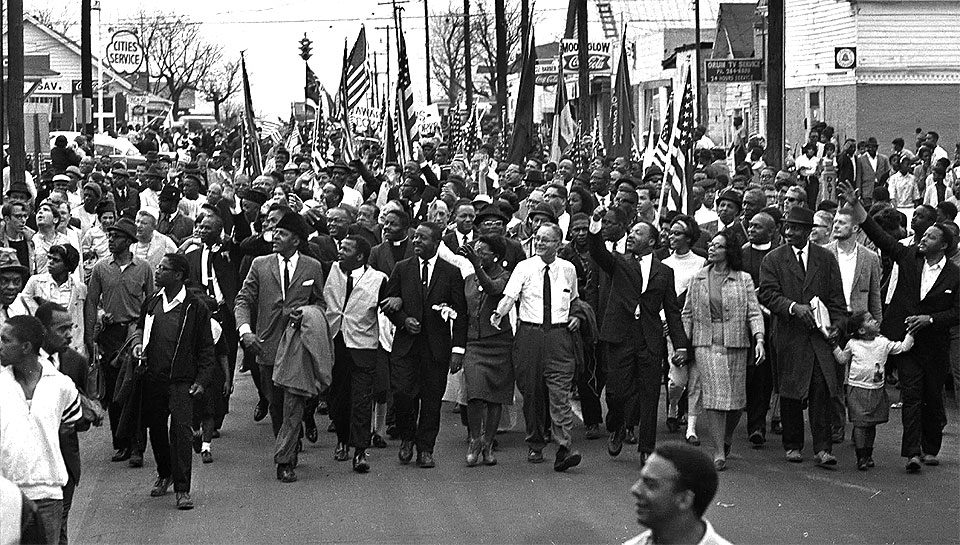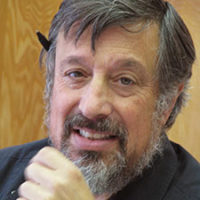
The flight to Atlanta was bumpy. I was already apprehensive. I had imagined being on the receiving end of a two-by-four swung wildly by a Southern gentleman of the White Citizens Council. And then, when the plane suddenly plunged downward in what felt like a nosedive, I feared I would soon meet my fate, denying the white racist the pleasure of bludgeoning me to death.
But as luck would have it, the plane was just making a precipitous landing, which turned out to be uneventful after all.
As we traveled to begin our march, I enjoyed the school bus ride that cut through Georgia’s brick red soil into Alabama’s thick woods. Later, we traveled in integrated cars, but those not black among us took care to duck for the whole trip to Selma, lest we meet up with white racists in pickups ready to come out of their hideouts in the woods and pounce on us with shotguns blasting away.
I was among thousands nationwide who responded to Dr. Martin Luther King Jr.’s call to converge on Selma for the march to Montgomery in late March 1965. I arrived in Selma a few days before the big march. These are a few of the unforgettable memories that come to mind 55 years later.
One afternoon we went to picket the mayor’s house. No sooner had we gotten there than we were herded like cattle onto the back of cop cars for a ride to the local jail. Once in the jailhouse, our numbers grew fast until we were too many to be confined to the jail. So the authorities brought us outside and lined us up against one of the jailhouse walls. Across the street, white men, sticks, and batons in hand, waited impatiently, like hounds thirsting to pounce on their prey.
But by the time the last demonstrator arrived, there were a couple of hundred of us. By then, national media had arrived. Much to the chagrin of the white thugs, local authorities escorted us to a nearby gym and left us there, telling us we were free to go.
No way were we going to wander out into the night. The next morning, a large group of the media met us, cameras clicking, as we emerged from the gym single file on our way to the church where we were to have a rally.
***
One night, after one of the rallies, we were taken back to the churches where we had been staying. I was dropped off at a church, pitch dark outside. But it turned out to be the wrong one.
What now? I could hardly see in the darkness but I found my way to a back alley, of which Selma has many, and began jogging in the direction where I thought my church might be. Neighborhood dogs, luckily behind fences, began barking. Before long, my heart pounding a mile a minute, it felt like every dog in Selma was barking. I thought, “I’m dead meat” — not because of the dogs but because their barks would inadvertently give me away to some racist thugs on the prowl for civil rights volunteers to harm.
Eventually, I recognized the church, rushed to a nearby shed and hid. Within minutes a school bus unloaded several black civil rights workers. I rushed to meet them. As I did, much to my surprise, to my immediate left I saw a thin young black man emerge out of a garbage can.
***
The morning of the big march, I woke with a fever. I told myself, no way was I going to miss it. I didn’t come all the way to Selma for that to stop me. The experiences of witnessing Jim Crow in Houston in the mid-fifties, soon after migrating with my parents and sister from Buenos Aires, were forever implanted in my conscience. Doing whatever necessary to help eradicate the U.S. version of apartheid became one of my life’s goals.
And so hundreds, among them a nineteen-year-old Argentinian, crossed the Edmund Pettus Bridge, the scene of the bloody attack by Alabama state troopers and local authorities earlier that month. (Not until years later and after many political and personal struggles did I consider myself an American of Argentinian origin).
For the first day’s trek to Alabama’s capital, Montgomery, we marched unimpeded, flanked by the National Guard. A smaller group marched the whole way to the state capital, also safeguarded by National Guard troops. It turns out that Dr. Martin Luther King Jr. had persuaded President Lyndon Johnson to mobilize the Alabama National Guard to protect us from harm.
***
The initial viciously brutal, unprovoked attack on a peaceful group of demonstrators in early March 1965 had received national and international attention, eliciting the revulsion of millions. It made it difficult for the U.S. to project the image of a bastion of “democracy” at home but, even more so, abroad. The unpopular war on Vietnam raged on while liberation movements fighting U.S. imperialism and its local surrogates were sprouting throughout formerly colonized and neo-colonized nations in Africa, Latin America and elsewhere.
On March 24 several thousand people marched into Montgomery. More marchers were brought in by bus and car.
That night, the “Stars for Freedom” rally was held. Among many famed artists participating was the activist actor and singer Harry Belafonte.
The following day, March 25, some 25,000 people marched to the steps of the State Capitol, where Dr. King delivered the speech, “How long? Not Long!”
“The end we seek is a society at peace with itself, a society that can live with its conscience … I know you are asking today, how long will it take? I come to say to you this afternoon, however difficult the moment, however frustrating the hour, it will not be long.”
As a result of the civil rights struggles in our country, the 1965 Voting Rights Act was enacted and on August 6 signed into law by President Lyndon B. Johnson.
Today, as we confront intensifying struggles for democracy, equality, human rights, economic and social justice, it is well to remember Dr. King’s words.












Comments